Whoever suggests you to build an MVP to test your assumptions is going after your money. Yes, many minimum viable products found success in the early 2010s, but only because the market wasn’t oversaturated with apps.
The main problem with developing an MVP these days is customers no longer tolerate compromises. An app’s esthetics, features, security, and ease of use — everything must blend into a delightful user experience to gain any traction at all.
Does it mean there’s no reason to make a minimum viable product? No, it’s quite the opposite.
In fact, we recommend our customers take the MVP route all the time. However, there are a couple of things we do differently with MVPs at Topflight, including:
- focus on delightful instead of viable (MDP vs. MVP)
- add a secret sauce before coding an MDP
- apply the Agile methodology
If you want to learn what’s different with creating a minimum viable product vs. a minimum delightful product and find out about secret MVP development steps, join the party.
Key Takeaways:
- The answer to “How to build a minimum viable product?” is to build an MDP (Minimum Delightful Product), which means you need to develop a minimum viable product that delights end users.
- Minimum viable product development, done right, starts with rapid prototyping, which includes the creation of an interactive app prototype and user testing.
- Business owners often miss this essential aspect of developing an MVP: integrating their apps with a proper user feedback collection system.
Table of contents:
1. What is a Minimum Viable Product?
2. Targeting the Right Audience When Building Your MVP
3. MVP Examples
4. Why You Should Develop an MVP
5. Business Benefits of Agile MVP Development
6. Make a Minimum Viable Product in 5 Steps
7. Tips to Launch a Successful Minimum Viable Product
8. If You’re Working on a HealthTech MVP
9. 5 Mistakes to Avoid When Developing an MVP
10. How to Measure MVP Success: KPIs and Metrics
11. How Much Does it Cost to Develop an MVP?
12. Moving from MVP to Full-Scale Product
13. Creating an MVP with Topflight
What is a Minimum Viable Product?
MVP in app development has become a sort of a mantra. How about we strip the term to the bare bones?
When talking about mobile and web app development, MVP means an initial version of an app that goes public and has enough potential to attract investors and/or start generating revenue. How do you know if your app is an MVP?
- You have built it with the least amount of resources
- You have found yourself on the market faster
- You keep thinking about all the features you had to cut
Historically, MVPs leaned heavily on minimum. App owners were churning out half-baked applications to check how many users they could attract and how people used the app. For example, Zillow — the most popular real estate app — could get away with something like that:
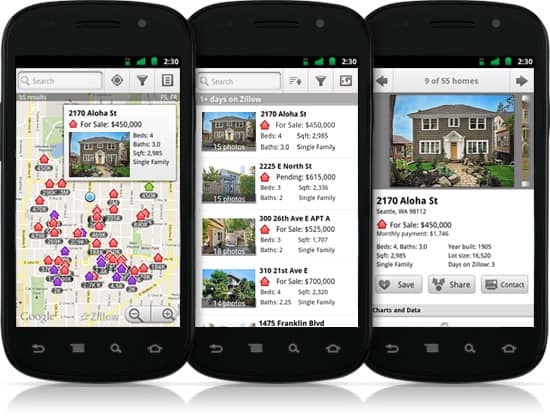
Today, with thousands of apps released per month (around 600 apps per day on iOS and 3,000 on Android), the focus has shifted to viable. Because the initial impression is everything, you can’t ignore how your app looks in a mobile store and how smooth of a user experience it provides.
Then again, some would say you can design an MVP version of software by talking to customers, researching social media, and running surveys to collect feedback. One thing they miss with this approach is the product. There’s no product when all you have is customer feedback on an imaginary solution.
What MVP means to app developers
Surprisingly, custom app development companies (most of them) often see an MVP differently than app owners.
For many app developers, planning an MVP is figuring out how many features they can squeeze into the initial app version given the budgetary and time restraints. They are more interested in fully allocating a budget than in delivering a product customers need.
That’s because a typical app development company believes you build a minimum viable product to verify your business idea and then pivot based on the customer feedback. And that’s an OK approach if you can throw, say, $50K on an initial version of your app and then spend another $70K on building the “real” product.
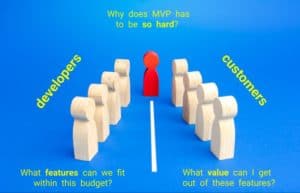
What MVP means to business owners
Contrary to that, business owners want to spend the minimum resources on a new product that their customers will love enough to stick around and eventually convert. So they are focusing on the two aspects of the MVP: minimum and viable.
Undoubtedly, you build your MVP to start a profitable business or extend your company’s services. Not purely to check how well you can perceive market needs.
Why MDP is a better approach
At Topflight, we believe that if you focus on all three aspects, including product, you’ll inevitably end up with a Minimum Delightful Product (MDP).
In short, it’s too expensive to create an MVP for a startup, spending anywhere between $30,000 and $60,000 only to find out that nobody needs these features or understands how to use them.
In the 2020s, product design is going to be everything. Users have gotten spoiled with the slick UX of modern web and mobile apps. That’s why your MVP must be delightful the first time they launch your app, not just viable, regardless of whether you’re going after an MVP website or mobile solution.
Related: Mobile App Design Tips to design successful apps
Would you use any of these viable apps today?

On the other hand, an MDP still has the minimum part. Therefore, your app development budget gets the uttermost attention, which means we look for ways to build just enough to delight while spending as little as possible.
The key takeaway: an MVP can mean different things to different audiences. Ensure your development partner aligns with your vision on all three aspects: minimum, viable (or delightful), and of course, product.
Targeting the Right Audience When Building Your MVP
Let’s say you want to build a weight loss app, which frankly is quite a feverish category these days. How do you achieve the best traction upon releasing an MVP and make sure your app stands out among other applications?
Well, you might think the success will depend on a killer feature — something your competitors have overlooked in their mobile products. Or you might consider integrating your mobile application with a new exciting sensor that helps people to achieve their health goals faster. Or it may be the ubiquity of your solution: it will support all possible phone models, tablets, smartwatches, desktop browsers, etc.
While all of that obviously matters, the one thing app owners often miss when chasing an MVP is aligning features to the actual needs of their target audience. Therefore, zealously focus on the problem you’re solving.
Launching an MVP with a custom mobile app development strategy allows for faster iterations and market feedback.
Who are the people who will use the app? How do they go about their day, and what are their major pain points? Do they have some habits that may interfere with getting the most value out of your product? Are they mostly male or female? What age? What’s their income? Are they on a diet?
Researching your target users as much as possible is the only way to ensure your app genuinely caters to their needs. The times of developing general apps like Uber that work for everybody are gone. Today, it’s all about serving different market segments.
As you go through market research, you’ll create a customer persona profile — a generalized representation of your ideal customer. Try including as much unique data on the profile as possible:
- personal background
- professional background
- lifestyle
- challenges and goals
- worries and fears
- a summary of a typical day
The key takeaway: no one knows your ideal customer persona better than you. So, before building an MVP, come well prepared — with an accurately developed buyer persona and one or two use cases that the product will solve.
MVP Examples
As I mentioned, modern MVPs look different from what they used to be in the past. Let’s look at two examples to give you an idea of what you should expect from your MVP of an app.
Uber — a good-old-days MVP
Initially, Uber was an iPhone-only app that allowed users to order a black cab at a discounted price and pay for the service with credit cards. It looked like this:
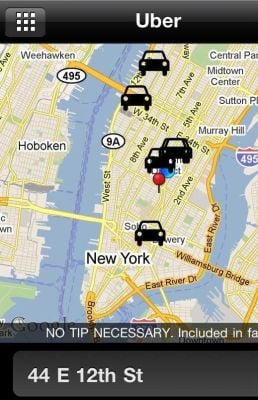
There was no Uber X, no ride booking, no sharing location in real-time, no other advanced features. Still, the app delivered on its promise to get a cheap ride from the user’s phone, and the business it helped to build is worth $78 billion today.
Helpkin — a modern MVP
Here’s one of the successful MVPs (or, rather, MDPs) that we’ve recently worked on. Helpkin is an app for trading time with friends for babysitting. Check out the looks:
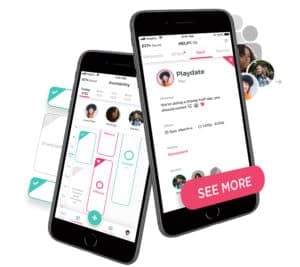
That is what you need these days to gain early adopters’ support. You can’t rely purely on core functionality to achieve recognition and have to balance an app’s performance with its UX/UI. Helpkin, for example, sold to an even bigger parenting startup called Wana.
The key takeaway: even if your app aims to create a new niche, you can’t focus solely on the MVP’s features. In reality, it takes keeping in balance all app aspects, such as design, security, and ease of use, among others.
Why You Should Develop an MVP
We kind of already covered why MVPs are great, but let’s summarize the reasons for building an MVP of your app here for convenience. So you make an MVP app:
- to enter the market faster
- to reduce the development costs
- to grab customers’ and investors’ attention
- to perfect your business model
In fact, there are practically no other options besides starting with an MVP. Remember, there’s no perfect, full-featured version of your app. If you build the MVP right the first time, your product will continue developing over time.
Look at Tinder and their most recent app updates for an example of a thriving app that started with a minimum viable product in 2012. They update the app at least twice a month, adding not only bug fixes but also introducing new features, such as video chats:
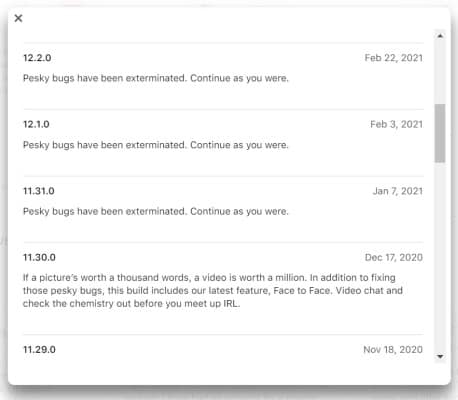 The key takeaway: start with an MVP to get a working solution faster and at a lower cost.
The key takeaway: start with an MVP to get a working solution faster and at a lower cost.
Business Benefits of Agile MVP Development
We need to cover one more thing before moving to the practical steps of MVP development — agile. This modern software development framework holds much potential for releasing a successful MVP. How does it work?
First of all, agile implies continuous product development. You get work on UX/UI improvements simultaneously with developing new features or perfecting existing functionality.
In practice, the agile approach involves the following activities, coordinated by you and your development partner:
- keep a backlog of all features for the MVP
- pick top-priority features for implementation during consecutive biweekly intervals
- track the progress and adjust each following interval (sprint) based on the outcomes of a previous sprint
- deliver intermediate results after each sprint
- Increase velocity and effectiveness of the development process based on performance during each sprint
The reason why companies like Google or Procter & Gamble lean toward agile is that the framework has proven beyond doubt its ability to generate intrinsic business value. What are the advantages of practicing agile while building an MVP?
- faster time to market
- better product-market fit
- uninterrupted development process
- max ROI given the time and budgetary limitations
- complete transparency in how your product is shaping
This advice to stick with an agile development framework applies not only to MVP but pretty much any other digital product development. Simply because it’s beneficial to both customers and business owners: customers get a product they really need, and business owners get into the position to scale further.
Make a Minimum Viable Product in 5 Steps
How to create a minimum viable product? Ok, it’s time to share the actual activities you should expect when starting an MVP. I’ll begin with explaining our secret sauce because it’s also the first step, and it’s designed to save time and money on MVP development. Then, we’ll go over the rest of the steps to build an MVP app.
| Step | Description |
|---|---|
| 1. Prototype | Create a clickable, interactive prototype of your MVP with essential features and user flows to mimic a real-world application. |
| 2. User Test | Validate the app concept with real users by collecting feedback and refining the prototype based on their reactions and suggestions. |
| 3. Code MVP | Develop the MVP using the most suitable tech stack, focusing on features that deliver immediate value and support scalability. |
| 4. Test MVP | Conduct thorough functional and stress testing to ensure the MVP is bug-free and performs well under load. |
| 5. Deploy MVP | Release the MVP to a production environment, track user engagement, and collect feedback for future updates and improvements. |
Step 1: Prototype
Every successful app we’ve built started as a rapid prototype. Because all the features and user flows you plan should be translated into tangible app screens. After all is said and done, the actual application screens are what makes up the core of your application MVP.
So when building an MVP, we pick one or two essential features, define the user flow, and create the design that is supposed to trigger the respective user experience. From wireframes to high-fidelity mockups, each screen finds its shape and form.
Finally, we interconnect all screens to mimic a real-world application where it responds to mouse clicks by switching screens. That gives us a virtual version of the MVP (minimum viable product design) that we need for the next step.
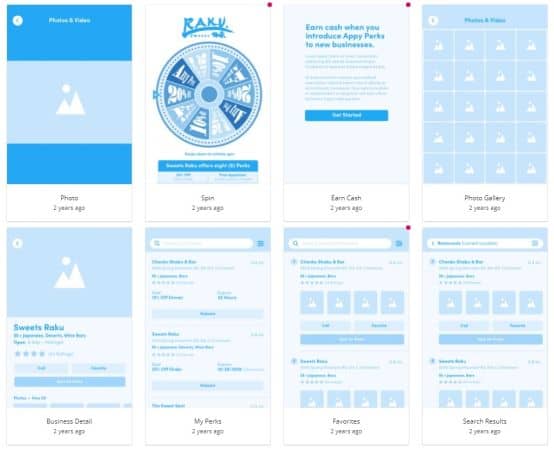
Step 2: User test
The only reason we craft a clickable, interactive prototype at the first step is to verify your app concept with real users. That’s precisely what we do during step number two: enroll users that match your demographic criteria for the target audience, using services like usertesting.com.
Related: The Complete Guide to User Testing
When testing, pay attention to subjective feedback from users and watch their reactions in recorded sessions as they work through your prototype. The insights you’ll uncover in the process will help with adjusting the prototype.
The key here is you are not spending your seed money on actual development yet. No code is written. That’s how you pivot fast before spending all your money on an MVP.
Step 3: Code MVP
A click-through prototype that has gone through user testing is ready for app developers. They can start fleshing out the MVP by writing code and integrating it with third-party solutions via APIs.
Experienced app development agencies often have their engineers double-check the prototype for technical feasibility before the development stage. Unfortunately, not every app design can be easily converted into code.
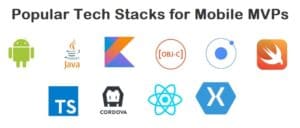
At the coding step, it’s critical to pick the most relevant tech stack. Ideally, you should choose something easy to scale and integrate with other systems down the road.
Please remember to focus only on features that immediately impact ROI and add value. I’m not saying you should aim for a single feature, but two should be enough already. You’ll get to work on all the bells and whistles once the product has been released and generated some traction.
Related: Choosing the right tech stack for your application
Also read: React Native vs Swift: Which is the better choice?
Step 4: Test MVP
No, it’s not overkill by any means to test your MVP thoroughly. As mentioned above, you’re releasing a product that is supposed to delight potential users, even though it comes with limited functionality. Therefore, it’s critical to the project’s success to verify an MVP’s quality.
At the minimum, you should account for functional and stress testing. Functional testing uncovers bugs in features, and the latter ensures the solution keeps working flawlessly regardless of the number of users.
You can launch an MVP only after thoroughly testing it. Please note that testing should take place throughout the entire process of building an MVP, starting from the very early versions.
Related: A Comprehensive Guide to Quality Assurance: Steps, Best Practices, Challenges
Step 5: Deploy MVP
This step is pretty obvious: you need to make the MVP publicly available by moving it to a production environment and uploading mobile applications to the App Store or Google Play.
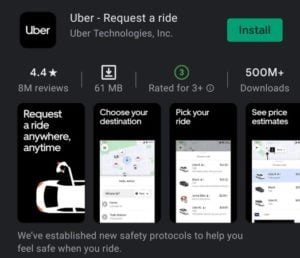
Most app owners think of the deployment step as final. However, with your app out in the wild, things are just starting to get really exciting.
Related: Guide to building a healthcare app
If your development team has done everything right, the MVP will have Google Analytics or other means of measuring user engagement. The user behavior data coupled with actual user feedback will help you prioritize features for the subsequent updates based on validated learning about customers.
The key takeaway: build the MVP as a scalable, extendable solution so that you don’t need to start from scratch after the market has embraced it. In this regard, creating MVP in mobile app development is no different than making an MVP for a web app.
Tips to Launch Successful Minimum Viable Product
Let’s quickly review some of the best practices for making a successful MVP.
- Think through how you are going to get feedback from users
Available options include Google Analytics, mobile analytics, built-in support platforms like UserVoice, and user review monitoring services like AppFollow. These vary depending on the type of app you’re building from healthcare app development to fintech app development.
- Treat your MVP like a finished full-fledged product all the way to the App Store/Google Play
Every little detail in the app description should be perfected to make customers want to download your app.
- Avoid using brand-new technologies
You need to choose your tech stack carefully to avoid re-developing your solution from scratch later on because it can’t scale or doesn’t work with other platforms.
- Consider releasing your MVP for a small target market group of customers
This approach will help you increase the probability of creating greater traction upon the public release.
- Include a sound monetization strategy
Some app owners believe that since it’s an MVP, you can’t charge for it. Quite the opposite, the commercial success of your MVP will be one of the key parameters to judge its success, making an app monetization strategy of key importance.
- Hire a dev team that practices a lean startup methodology
Teams using Scrum, Kanban, or other flavors of Agile deliver faster and catch most of the issues even before testing begins.
Related: Agile App Development: Complete Guide
If you want more advice on minimum viable product development or want us to assess what you already have to find the best way forward, schedule a free consultation. We’ll be happy to help you plan a minimum viable product and talk you into going with a minimum delightful product.
If You’re Working on a HealthTech MVP
Creating a Minimum Viable Product (MVP) for a health tech app involves unique challenges. To manage scope and budget effectively, it’s crucial to prioritize certain strategies:
Consider White-Label Solutions
Using white-label platforms can be a game-changer during the initial phases of development. These ready-made solutions allow you to launch quickly and affordably, offering essential functionalities without the need for extensive custom work. As your app scales, you can transition to a more tailored solution that better fits your growing needs.
Delay Full HIPAA Compliance
HIPAA compliance is essential for handling Protected Health Information (PHI), but achieving full compliance can be resource-intensive. For your MVP, start with features that do not store or process PHI. This approach allows you to reduce early development costs while planning to incorporate necessary security measures and compliance protocols as soon as possible.
Postpone EHR Integration
Integrating Electronic Health Records (EHR) from the outset can significantly increase complexity and cost. Evaluate whether EHR integration is necessary for the initial release. Focus on building core features first, and add EHR integration in later stages. This phased approach helps maintain control over the project scope and budget.
Leverage No-Code/Low-Code Platforms
No-code and low-code development platforms enable you to expedite the building process and reduce costs. These tools allow you to develop and test your app quickly, gather user feedback, and iterate faster. Keep in mind their limitations in terms of customization and scalability, particularly for advanced medical features.
By strategically prioritizing these elements, you can keep the scope of your health tech MVP under control. This ensures that you deliver a functional product within budget and on time, setting a solid foundation for future growth and compliance as your project progresses.
5 Mistakes to Avoid When Developing an MVP
What are the common pitfalls you’d better sidestep during MVP app development to release a successful product?
Postponing monetization to future product updates
If you treat your MVP as a finished product from day one, why shouldn’t it have a solid monetization strategy from the get-go? After all, your customers don’t care if it’s only an MVP or some other abbreviation — to them, it’s a finished product.
- think through the monetization strategy during the discovery phase
- apps that rely on a subscription model tend to perform better
Too many or too few features
Avoid adding too much or too little functionality. Every feature should add value and have a direct impact on ROI. What often happens during development is an app owner gets overly excited seeing her app coming alive. As she starts playing with early versions, new ideas spring to life, and it’s critical to evaluate what impact these new ideas may have on time to market, cost, and ROI.
- instead of adding new features during development, replace previously planned options or postpone development if new features won’t noticeably impact the ROI
Building entirely from scratch
Today, software developers have plenty of tools (open-source and commercial) they can use to jump-start MVP product development. There’s plenty of SDKs, APIs, libraries, and other code templates that help you realize features like chatting or mapping in days instead of months.
- use reliable third-party tools to pick up the development pace
Unfit development approach
As mentioned, agile and the lean methodology is perfect for creating an MVP. If you decide to go with a fixed-price approach, setting rigid frames for delivery and budget, you risk releasing an application that lacks the product-market fit and can’t address all user needs effectively.
With any software development, there are a lot of assumptions being made about end customers and their behavior. Fortunately, agile allows you to verify those assumptions and adjust on the fly during the project.
- make sure your app agency follows agile principles and keeps you in the loop throughout the project
Ignoring the marketing budget
Another common mistake is to blow all raised money solely on development, ignoring the marketing initiatives. Remember that every day there appear more and more apps, and they all compete for the spotlight. So not setting aside the marketing budget from the beginning would be precarious. No matter how good the product is, it won’t sell itself until people have seen it.
- determine your marketing budget before you start an MVP project
Lack of analytics post-launch
Once you launch an MVP, you’ll need to analyze its performance: whether it hits your targets in terms of the user base, active subscriptions, etc. Of course, you need to integrate with app analytics services like Flurry or Mixpanel while making the MVP to be able to collect all this data when the app is live.
- connect your app with an app analytics service beforehand
How to Measure MVP Success: KPIs and Metrics
Every digital product has its destiny. How do you know if yours takes you to the desired destination? You should already know the answer if you’ve paid attention to the typical mistakes app owners make when working on an MVP.
Of course, you need to track the app performance by using various app analytics services. You can pick from Google Analytics, Flurry, Mixpanel, and a handful of other similar services that help you identify how users interact with the solution.
In fact, it’s very similar to SEO best practices applied to websites. For example, just like on a site, you can have sales funnels that take visitors through a series of steps, the mobile app or a web solution allows you to track the same.
Also Read: App Metrics to Measure App Performance
That’s how you get insights into whether your customers use your app the way you intended to or face some navigation issues or understand some features.
Ultimately, measuring the success of your MVP comes down to tracking various metrics, e.g., the number of daily active users or average revenue per user. We have a DIY guide detailing critical app metrics and explaining how to monitor them if you’d like a deeper dive.
Remember that the tools used to monitor and evaluate app performance need to be in place before you launch the app. Take care of that during development. Take care of that during development.
How Much Does it Cost to Develop an MVP?
It usually takes between $100,000 and $150,000 to develop a minimum viable product. However, your budget will totally depend on the key features you envision. As you can imagine a minimum viable product with machine learning or other sophisticated functionality will require a more substantial effort than an average patient app (which usually takes less time, therefore, a smaller budget).
Also Read: App Development Costs: Everything you need to know
Moving from MVP to Full-Scale Product
Finally, how do you transition from an MVP stage to developing a full-scale final product? The trick is if you’ve followed the recommendations in this blog, you’re already set up for scaling your solution.
Agile best practices ensure that you continue focusing on app performance in real time, adjusting existing features while working on a larger roadmap for the product. What will it look like in a year to five years from now, given the market conditions? What new use cases may emerge to replace or enhance the current ones?
Also Read: Custom Mobile App Development Guide
If your team uses agile for developing your product, that means you’re well prepared for any market moves. You will be able to effectively address the changes because your product matures every two weeks. Remember that it’s all about building a minimum viable product that generates traction with potential customers.
Creating an MVP with Topflight
If you need minimum viable product development services or want to figure out the best way forward, schedule a free consultation. We’ll discuss the best strategy for your minimum viable product.
Related Articles:
[This blog was originally published in May 2021, and was updated for more recent data]
Frequently Asked Questions
How long does it take to develop a minimum viable app?
The development time is one to three months, depending on what product you envision.
Can a landing page or a video serve as a minimum viable product?
If your customers can use them as a product, yes. Otherwise, you’ll need something more tangible.
Should I build an MVP or an MDP?
If you are looking to delight your customers, go with MDP. After all, it’s almost the same as a traditional MVP, only better by the UX and user testing.
How to decrease the cost of the MDP development process?
Create and verify an interactive prototype before programming the application. Market validation starts with prototyping.
How to build a minimum viable product using app builders?
You can use application building services like BuildFire or Appy Pie, but be ready to ditch the results once the solution generates a substantial user base. You need natively built products to scale appropriately.

